The Trusty Metal Detector
In September, a retired treasure hunter in Australia hit the mother load. He had been searching for years with no great results but this day his ship came in. He unearthed a gold nugget weighing more than 7 pounds, containing 68 troy ounces (4.5 pounds) of gold.
It took him about 2 hours to dig it out. The value of his find: $80,000! That equates out to $40,000 per hour, not a bad day’s work.

Our Last Regular 2018 Meeting
It’s arrived again. Our last regular meeting of 2018 is this Thursday, November 1st at 7:00pm. Lot’s of information and fun for members and visitors. Don’t forget our club auction, interesting coins and medals at great starting bids.

Our club auction could be a fabulous opportunity to pick up that collector friend on your list a meaningful & appreciated Christmas gift!
There are only about 8 weeks left until Christmas!
Want Proof?
Although the Mint struck proof coins prior to 1858, it was in that year that the first complete proof sets were sold by the Mint to the public at large. As far back as 1817, proof coins were available for purchase, individually, by collectors and ordinary citizens, if they contacted the Philadelphia Mint and requested them.
A complete set of proof coins from the year 1858 totaled 13 different coins. How many can you name? Hint: there were 7 coins with copper or silver content; there were 6 gold coins.

2017 Proof Set
You Never Know
What’s that? It’s a coin of some type.
You never know when the next interesting coin will show up. One did for me last week. I was returning a rental truck and something caught my attention on the ground in the parking lot.
It was a coin or a token of some sort, but it was a lot thicker than a coin should be. It wasn’t in the greatest condition. How long had it been laying in the parking lot?
Upon closer inspection the coin appeared to say “One Pound” on it. After a little time on the internet, I found out that it was a 1996 one pound British coin depicting the Celtic cross of Northern Ireland. How a British Northern Ireland coin ended up on a rental truck parking lot in Dayton, Ohio I’ll never know.
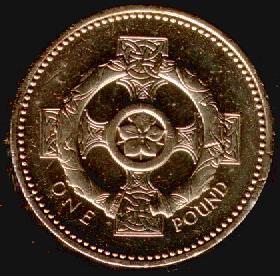
Reverse of 1996 £1 Coin
I found out that it was decided that from 1984, British £1 coins would feature different reverse designs for each of the four parts of the United Kingdom. All £1 coins dated 1996 feature on the reverse a Celtic cross symbolizing Northern Ireland. The coin was demonetized last year and is worth only about $1.30 U.S.
But the story of how and where I found it… priceless!
(This is what my coin could have looked like… before it was run over and left in a parking lot! Keep you eyes peeled! You never know what coin may be out there just waiting to be found.)
Next Meeting This Week
Our next club meeting is this Thursday at 7:00pm. See you there, bring a guest. Let’s grow our club!

Reeded Edges
Did you ever wonder why the U.S. Mint began reeding the edges of gold and silver coins?
One reason was to keep would-be criminals from “shaving” the edges of precious metal coins, gathering the filings, and then selling the gold or silver. As a side benefit, the reeded edges also made our coins more intricate and harder to counterfeit.
Reeding has also gained some provenance to coin collectors. The 1921 Morgan Dollar has a “wide edge” reeding and a “normal’ edge reeding. Wide edge reeded Morgans feature 157 reeds (VAM 44), while the normal variety has 189.

189 Normal -Top
157 Wide – Bottom
Beginning in 1836, the Mint reeded all silver and gold coins with two exceptions. Can you name these two exceptions?
1963-B $1 “Barr” Notes
Joseph Barr served as Secretary of the Treasury only 28 days, from 12/21/1968 to 1/23/1969. The thought would be that Federal Reserve Notes with his signature would be rare. Not true!
The notes were produced for only 5 Federal Reserve Districts: New York, Richmond, Chicago, Kansas City, and San Francisco. However 471,200,000 notes (including star notes) were issued. Given this number and the fact that they were printed less than 50 years ago, they are quite common.
What is different about the 1963_B $1 series is that it was the last series to include the old Treasury Seal that had its inscription in Latin:
THESAUR.AMER.SEPTENT.SIGIL ( “The Seal of the Treasury of North America).
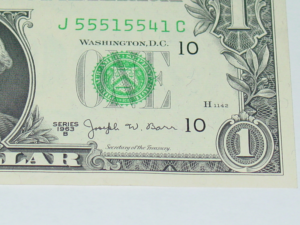
The new seal is inscribed in English and has been in use since 1968.

September 6, 2018 Meeting
Our next meeting is two days away. We will be having our monthly coin auction so be ready to sell or buy. There will be some great deals to be had!

$2 Bills – Five Basic Facts You May Not Know
- Thomas Jefferson is not the only person to appear on a $2 note. Alexander Hamilton was on the 1862 Legal Tender Note. Winfield Scott Hancock appeared on the 1886 $2 Silver Certificate. William Windom was pictured on the 1891 $2 Silver Certificate. Civil War General James McPherson was represented on the 1891 Treasury (Coin) Note. And then there was some guy named George Washington on the 1899 $2 Silver Certificate. Then there was a lady named Science on the face of the 1896 Educational Series $2 Silver Certificate.
- When you visit Monticello, Jefferson’s home, you will receive a $2 bill as change when making a purchase of a tour ticket or souvenir.
- When attempting to fit the picture of the signing of the Declaration of Independence on the back of the 1976 $2 Note, the signers on the extreme left and right in the picture where omitted.
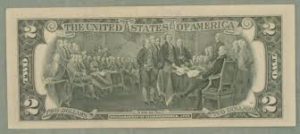
- The image on the back of the 1976 Note is NOT the signing of the Declaration. It is the representation of the Declaration being PRESENTED to the Continental Congress.
- Yes, they still produce $2 bills! The Bureau of Engraving and Printing print them in Fort Worth, Texas.
The Dahlonega Mint
After the discovery of gold in the 1820’s in the region of northern Georgia, citizens began clamoring for a regional mint to coin their gold. Their yearnings fell on sympathetic ears in Washington D. C. In 1835 President Andrew Jackson signed into law a bill establishing mints at Dahlonega, Georgia and Charlotte, North Carolina.
Set to open in the spring of 1837, construction problems delayed the opening until February of 1838. It took until April for the mint to receive enough gold ingots to begin coin production.
Dahlonega produced only half-eagles in 1838 and today an 1838-D half-eagle in VF condition is worth about $4,000.
The first quarter-eagles were coined in 1839. Less than 14,000 were struck. What is unusual about the 1839-D quarter-eagle is that they are all overdates (1839/8). Today, an 1838/9-D quarter-eagle is worth about $5,800 in EF.
The Dahlonega Mint operated until the Civil War broke out when it was seized by the governor of Georgia, Joseph E. Brown. By war’s end, Union troops had recaptured the mint, which although never again used to coin gold, remained open until being officially closed in 1873.
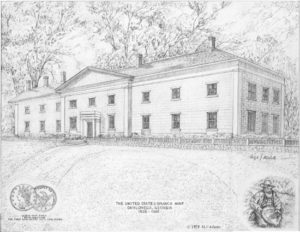
Next Club Meeting August 2
Our next meeting and club auction will be next Thursday, August 6th. Plan to attend and maybe sell something or buy something new for your collection.

See a Penny…
Everyone collects or collected pennies (cents) at some time during their life. Well, you ain’t got nothing on this guy! Check out this video
You’re Kidding, Right?
When Liberty Nickel production was started in 1883, the first type did not have the word CENTS on them. Most people have heard about “Racketeer Nickels”, where unscrupulous individuals reeded the edge of the no-cents nickel, plated them with gold, then passed them off to unsuspecting merchants as $5 gold pieces.
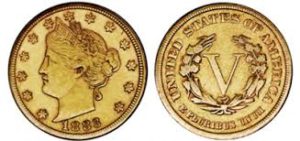
The Mint caught on to this fairly quickly (about 5 million coins into the run, if that’s quick) and added the word CENTS to the reverse. The racketeers kept the Secret Service quite busy chasing down the passers of these nickels.
No one is sure who the first “racketeer” was. Many writers at the time related that a man named Josh Tatum was arrested and convicted of passing these plated golden nickels. What you may not know is that this is where the term, “You’re joshing me!” originated.
Would I kid you?
On June 10, 1652…
In Massachusetts, silversmith John Hull, at age 28, opened the first mint in America, in defiance of English colonial law. The first coin issued was the Pine Tree Shilling, designed by Hull. This mint produced coins from 1652 to 1682 (or 83). As compensation, Hull was allowed keep 6 percent of all the silver he minted.
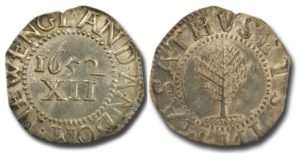
The deal was a sweet one. In England, the official mint-masters of the Crown were allowed to keep about 3 percent of the currency they struck – and they still got rich.
Thursday June 7 Meeting
From James Willis:
“William T. Gibbs ( managing editor @ Coin World ) has graciously agreed to be our guest speaker, be sure to attend I’m sure it will be an interesting presentation.”
Bring yourself and invite guests as this will be an outstanding meeting!
On June 6, 1872…
She was arrested, convicted, and fined for casting a vote in a Presidential election in her hometown of Rochester, New York. When she refused to pay the fine, authorities declined to take further action against her.
She traveled extensively, giving anywhere from 75 to 100 speeches per year. Because of her and a friend, Elizabeth Stanton’s hard work, Senator Aaron Sargent (R-CA) introduced to Congress the Nineteenth Amendment to the U.S. Constitution, the amendment that gave women the right to vote in U.S. elections. The amendment was finally ratified in 1920, fourteen years after her death in 1906.
In 1979, Susan Brownell Anthony became the first actual woman to be depicted on U.S. coinage, the Susan B. Anthony dollar.
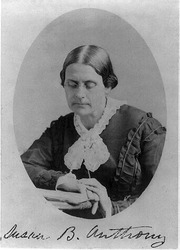
Next Club Meeting & Auction

Thursday June 7th is our next meeting and club auction.
Make plans to attend. The public is invited.
A Veteran’s Grave & A Coin
In America, the practice of leaving a coin on a veteran’s gravestone became widespread during the Vietnam War era. Because of pro and anti-war sentiments in the ‘60’s and 70’s, many fellow soldiers chose to leave a coin on their buddy’s gravesite. The coin was to represent the “down payment” for the next round of drinks when they were reunited.

Today, the denomination of the coin left signifies how close the personal relationship was between the fallen and the still living. A penny means you visited, a nickel means you were together at boot camp. A dime shows you served together and a quarter signifies that you were with them when they died.
Many cemeteries gather the coins left on soldiers’ graves and use them to pay for burial of veterans in need. So why not give a coin salute when you visit the cemetery this year? You’ll be paying your respects and letting someone in the family know you visited. Let’s carry on a wonderful, time-honored tradition.
May 23: Lucky Penny Day
Test your knowledge of pennies, cents, and other single denominations.

- Large cents were last minted in what year?
- Name the former British colony that issued a one-cent piece of paper currency and what year was it printed?
- Why was Abraham Lincoln chosen to be the first President to appear on a regularly circulating coin in 1909?
- The safety bicycle was developed in the 1800s as an improvement over what type of bicycle? Why was the earlier bicycle given that name?
- What is a “pickle barrel” cent?
- What nickname was given to Indian Head cents before 1866?
- In what year did Canada mint a commemorative cent and what was the occasion?
- Besides their composition, what is the other difference between copper alloy and copper-plated zinc cents?
- Fugio cents were minted in 1787. What does the word “Fugio” mean and who was given credit for designing the coin?
- The 1909-S V.D.B. has the lowest mintage number for the Lincoln cent series. What is the cent with the second lowest mintage number?
Answers
- 1857
- Hong Kong in 1961
- The 100thanniversary of Lincoln’s birth.
- Penny Farthing: the large front wheel was reminiscent of a British penny compared to the smaller back wheel.
- Large cents that were thrown into pickle barrels that cause the pickles to turn a brighter, more appetizing, green color.
- Nickels or Nicks – because the planchets contained nickel.
- 1967 – the 100thanniversary of the Canadian Confederation.
- A weight difference: copper alloy 3.11 grams; copper-plated zinc 2.5 grams.
- Fugio – time flies; Benjamin Franklin
- 1931-S; only 866,000 minted
Have You Ever Been Given A Wooden Nickel?
The proverbial wooden nickel has been around since the 1930’s. As a matter of fact they are a direct result of the Great Depression. Read on!
Due to the failure of a bank in Tenino, Washington on December 5, 1931, a severe shortage of money occurred in the region. To replenish their cash drawers, merchants would have to travel about 30 miles across treacherous mountain roads in cars ill suited to that purpose. The average round trip took up to four hours. A meeting of the town’s Chamber of Commerce resulted in a local newspaper printing up the first issue of wooden money in the U.S.
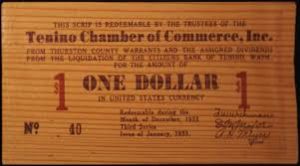
The first wooden “coins” were issued in 1933 in Blaine, Washington when the town’s bank also failed. Soon after that the issuing of wooden coins in the Pacific Northwest gained momentum.
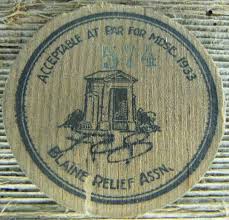
As our country moved ahead in the later 1930’s, and the Great Depression continued, the use of wooden money “grew” if you’ll pardon the pun. In Chicago in 1933, the first use of wooden nickels as souvenirs occurred. In 1934 wooden nickels began to be used as advertising pieces. In 1938 the J. R. Roger’s company of Fostoria, Ohio obtained a copyright for their design of wooden money. Even Canada got in on the act. Among their wooden money was the Spruce Dollar from British Columbia.
Today wooden nickels are everywhere. Beer companies use them. Fast food companies such as Dunkin’ Donuts, Pizza Hut, Dominos, Church’s, and even Burger King issue souvenir “wooden nickels”.
And speaking of King, there are even wooden nickels with “The King”, Elvis Presley on them.

Clubs and Associations
- American Numismatic Association
- American Numismatic Society
- British Numismatic Society
- Central Ohio Numismatic Association
- Central States Numismatic Society
- Florida United Numismatists
- Numismatic Society of India
- the Cincinnati Numismatic Association
- The Royal Canadian Numismatic Association
- The Royal Numismatic Society
Coin Links
- Boy Scouts Merit Badge
- Buffalo Nickels
- Bureau of Engraving and Printing
- Calculate your coin's gold, silver, or metallic worth
- Coins & Currency in Colonial America
- David Lawrence Rare Coins Reference Library
- Dayton Metro Library – Coin Books
- Fixing PVC damage
- Indian Head Cents
- Legandary Coins and Currency from the Smithsonian
- Medalblog
- Mints of the World
- Monnaie de Paris
- NapoleonicMedals.org
- raregoldcoins.com
- Royal Canadian Mint
- Smithsonian Institution Collection
- Starting a coin collection
- The Kittredge Collection
- The Perth Mint
- The Pobjoy Mint
- The Princeton University Numismatic Collection
- The Royal Mint
- United States Mint
- University of Virginia Coin Collection
- Where is my coin from?
Coin News
Miami Valley Coin Dealers
Speciality Clubs
- American Tax Token Society
- Barber Coin Collectors' Society
- Dayton Diggers Metal Detecting Club
- Early American Coppers
- Encased Collectors International
- Fly-In Club
- Liberty Seated Collector's Club
- Medal Collectors of America
- National Token Collectors Association
- Numismatic Bibliomania Society
- The Bust Half Nut Club
- The Civil War Token Society
- The Colonial Coin Collectors Club
- The Elongated Collectors
- The John Reich Collectors Society
- The Society of Paper Money Collectors
- The Token and Medals Society
- Unrecognised States Numismatic Society
- Worldwide Bi-Metallic Collectors Club